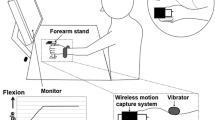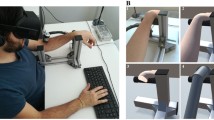Summary
The effect of muscle tendon vibration on the performance of some simple motor tasks and on kinesthesia was studied in normal humans. Subjects performed non-visually-guided slow arm movements to match either the position or the velocity of a visual target. In the experiments designed to study kinesthesia subjects indicated the perceived position or velocity of their passively moved arm. Vibration was applied over either the biceps or the triceps tendon. Position and velocity matching were found to be disturbed by vibration in essentially different ways, as were the perception of imposed position and the perception of imposed velocity. However, the vibration induced disturbance of position matching was congruent with the distortion of position perception. The effect of vibration on velocity matching was in accordance with the effect of vibration on the perception of velocity. It is concluded that the afferent information pathways that give rise to the perception of position and velocity respectively can be used separately in the control of slow movements under different conditions.
Similar content being viewed by others
References
Bianconi R, Van der Meiden JP (1963) The responses to vibration of the end-organs of mammalian muscle spindles. J Neurophysiol 26: 177–190
Burgess PR, Wei JY, Clark FJ, Simon J (1982) Signalling of kinesthetic information by peripheral sensory receptors. Ann Rev Neurosci 5: 171–188
Burke D, Hagbarth KE, Löfstedt L, Wallin BG (1976a) The responses of human muscle spindle endings to vibration of non-contracting muscles. J Physiol (Lond) 261: 673–693
Burke D, Hagbarth KE, Löfstedt L, Wallin BG (1976b) The responses of human muscle spindle endings to vibration during isometric contraction. J Physiol (Lond) 261: 695–711
Burke D, Hagbarth KE, Löfstedt L (1978) Muscle spindle activity in man during shortening and lengthening contractions. J Physiol (Lond) 277: 131–142
Capaday C, Cooke JD (1981) The effects of muscle vibration on the attainment of intended final position during voluntary human arm movements. Exp Brain Res 42: 228–230
Capaday C, Cooke JD (1983) Vibration-induced changes in movement-related EMG activity in humans. Exp Brain Res 52: 139–146
Craske B (1977) The perception of impossible limb positions induced by tendon vibration. Science 196: 71–73
Eklund G, Hagbarth KE (1966) Normal variability of tonic vibration reflexes in man. Exp Neurol 16: 80–92
Gandevia SC, Hall LA, McCloskey DI, Potter EK (1983) Proprioceptive sensation at the terminal joint of the middle finger. J Physiol (Lond) 335: 507–517
Goodwin GM, McCloskey DI, Matthews PBC (1972a) Proprioceptive illusions induced by muscle vibration: contribution to perception by muscle spindles? Science 175: 1382–1384
Goodwin GM, McCloskey DI, Matthews PBC (1972b) The contribution of muscle afferents to kinaesthesia shown by vibration induced illusions of movement and by the effects of paralysing joint afferents. Brain 95: 705–748
Hagbarth KE, Vallbo AB (1968) Discharge characteristics of human muscle afferents during muscle stretch and contraction. Exp Neurol 22: 674–694
Hore J, Preston JP, Durkovic RG, Cheney PD (1976) Responses of cortical neurons (areas 3a and 4) to ramp stretch of hindlimb muscles in the baboon. J Neurophysiol 39: 484–500
Horch KW, Clark FJ, Burgess PR (1975) Awareness of knee joint angle under static conditions. J Neurophysiol 38: 1436–1447
Lackner JR (1975) Pursuit eye movements elicited by muscle afferent information. Neurosci Lett 1: 25–28
Lucier GE, Ruegg DC, Wiesendanger M (1975) Responses of neurones in motor cortex and in area 3a to controlled stretches of forelimb muscles in cebus monkeys. J Physiol (Lond) 251: 833–853
McCloskey DI (1973) Differences between the senses of movement and position shown by the effects of loading and vibration of muscles in man. Brain Res 61: 119–131
McCloskey DI (1978) Kinesthetic sensibility. Physiol Rev 58: 763–820
McCloskey DI, Cross MJ, Honner R, Potter EK (1983) Sensory effects of pulling or vibrating exposed tendons in man. Brain 106: 21–37
Roll JP, Gilhodes JC, Tardy-Gervet MF (1980) Effets perceptifs et moteurs des vibrations musculaires chez l'homme normal: mise en évidence d'une réponse des muscles antagonistes. Arch Ital Biol 118: 51–71
Roll JP, Vedel JP (1982) Kinaesthetic role of muscle afferents in man, studied by tendon vibration and microneurography. Exp Brain Res 47: 177–190
Van Beekum WT (1980) The participation of muscle spindles in human position sense. Thesis State University Utrecht, The Netherlands
Author information
Authors and Affiliations
Rights and permissions
About this article
Cite this article
Sittig, A.C., van der Gon, J.J.D. & Gielen, C.C.A.M. Separate control of arm position and velocity demonstrated by vibration of muscle tendon in man. Exp Brain Res 60, 445–453 (1985). https://doi.org/10.1007/BF00236930
Received:
Accepted:
Issue Date:
DOI: https://doi.org/10.1007/BF00236930




